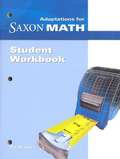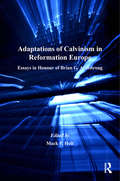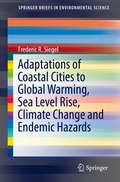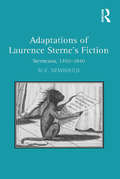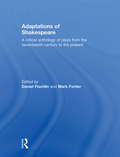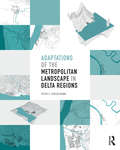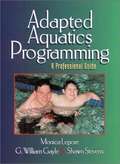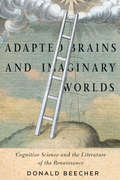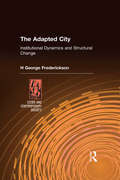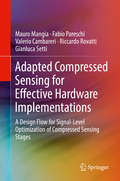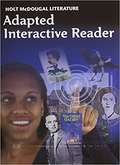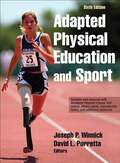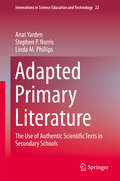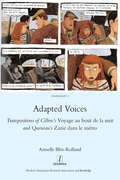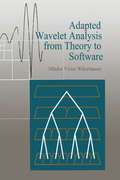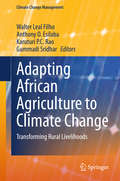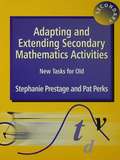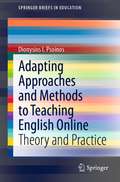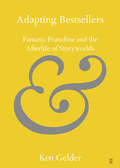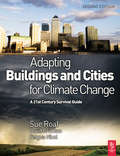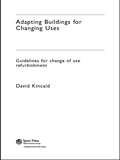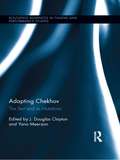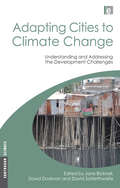- Table View
- List View
Adaptations of Calvinism in Reformation Europe: Essays in Honour of Brian G. Armstrong (St Andrews Studies in Reformation History)
by Mack P. HoltTraditional historiography has always viewed Calvin's Geneva as the benchmark against which all other Reformed communities must inevitably be measured, judging those communities who did not follow Geneva's institutional and doctrinal example as somehow inferior and incomplete versions of the original. Adaptations of Calvinism in Reformation Europe builds upon recent scholarship that challenges this concept of the 'fragmentation' of Calvinism, and instead offers a more positive view of Reformed communities beyond Geneva. The essays in this volume highlight the different paths that Calvinism followed as it took root in Western Europe and which allowed it to develop within fifty years into the dominant Protestant confession. Each chapter reinforces the notion that whilst many reformers did try to duplicate the kind of community that Calvin had established, most had to compromise by adapting to the particular political and cultural landscapes in which they lived. The result was a situation in which Reformed churches across Europe differed markedly from Calvin's Geneva in explicit ways. Summarizing recent research in the field through selected French, German, English and Scottish case studies, this collection adds to the emerging picture of a flexible Calvinism that could adapt to meet specific local conditions and needs in order to allow the Reformed tradition to thrive and prosper. The volume is dedicated to Brian G. Armstrong, whose own scholarship demonstrated how far Calvinism in seventeenth-century France had become divided by significant disagreements over how Calvin's original ideas and doctrines were to be understood.
Adaptations of Coastal Cities to Global Warming, Sea Level Rise, Climate Change and Endemic Hazards (SpringerBriefs in Environmental Science)
by Frederic R. SiegelThis book discusses the identification of, solutions to, and management of threats to high population coastal cities and their seaports from global warming, climate change and endemic hazards. These include prevention of sea water intrusion of freshwater coastal aquifers, emplacement of barriers that mitigate the threats from sea level rise, and inundation of urban centers plus those from storm surges that cause flooding and salination of inshore terrain. The book assesses mitigation of the effects of extreme weather events such as drought, and major flooding from heavy rainfall on coastal urban centers, or on associated drainage basins. It also considers how coastal cities can counter vulnerabilities from other physical hazards (e.g., earthquakes - building codes) and health hazards (e.g., pollution, public health response - preparedness) that may be related to a city’s geological/geographical location and service as a port of entry for goods and travelers (regional and international). The book also cites the high costs of safeguarding citizen and municipal assets, but notes possible sources of potential funding especially from less developed and developing nations. The book is written to give strong background information to students majoring in environmental sciences or those in other majors with interests in the effects of global warming/climate change, and will be of interest to social scientists, think tank personnel, government planners, and lay persons in environmentally oriented organizations.
Adaptations of Laurence Sterne's Fiction: Sterneana, 1760–1840
by Mary-Celine NewbouldExploring how readers received and responded to literary works in the long eighteenth century, M-C. Newbould focuses on the role played by Laurence Sterne’s fiction and its adaptations. Literary adaptation flourished throughout the eighteenth century, encouraging an interactive relationship between writers, readers, and artists when well-known works were transformed into new forms across a variety of media. Laurence Sterne offers a particularly dynamic subject: the immense interest provoked by The Life and Opinions of Tristram Shandy, Gentleman and A Sentimental Journey through France and Italy inspired an unrivalled number and range of adaptations from their initial publication onwards. In placing her examination of Sterneana within the context of its production, Newbould demonstrates how literary adaptation operates across generic and formal boundaries. She breaks new ground by bringing together several potentially disparate aspects of Sterneana belonging to areas of literary studies that include drama, music, travel writing, sentimental fiction and the visual. Her study is a vital resource for Sterne scholars and for readers generally interested in cultural productivity in this period.
Adaptations of Shakespeare: An Anthology of Plays from the 17th Century to the Present
by Daniel Fischlin Mark FortierShakespeare's plays have been adapted or rewritten in various, often surprising, ways since the seventeenth century. This groundbreaking anthology brings together twelve theatrical adaptations of Shakespeares work from around the world and across the centuries. The plays includeThe Woman's Prize or the Tamer Tamed John FletcherThe History of King Lear Nahum TateKing Stephen: A Fragment of a Tragedy John KeatsThe Public (El P(blico) Federico Garcia LorcaThe Resistible Rise of Arturo Ui Bertolt BrechtuMabatha Welcome MsomiMeasure for Measure Charles MarowitzHamletmachine Heiner MüllerLears Daughters The Womens Theatre Group & Elaine FeinsteinDesdemona: A Play About a Handkerchief Paula VogelThis Islands Mine Philip OsmentHarlem Duet Djanet SearsEach play is introduced by a concise, informative introduction with suggestions for further reading. The collection is prefaced by a detailed General Introduction, which offers an invaluable examination of issues related to
Adaptations of the Metropolitan Landscape in Delta Regions
by Peter C BosselmannAdaptations of the Metropolitan Landscape in Delta Regions is about environmental quality and the long term livability of urban areas. In decades to come, climate change will affect cities everywhere, but nowhere have the effects of climate change already been felt as strongly as in low-lying coastal cities, cities located in large river deltas and near tidal estuaries. This book reflects on the contribution that spatial planning and urban design can make to a complex discussion about how city form and landscapes will need to adapt within metropolitan areas. The book’s focus is on the urban form of three delta regions: the Pearl River Delta in Southern China; the Rhine, Maas, and Scheldt Delta in the Netherlands; and the San Francisco Bay Area in Northern California. The three regions differ greatly, but despite their different political systems, history, culture and locations in three different climate zones, all three regions will be forced to respond to similar issues that will trigger transformations and adaptations to their urban form. Richly illustrated in color with detailed diagrams, models, photographs and sketches, the book is written for students, scholars and practitioners of environmental planning, and designers who need to respond to the future form of cities in light of climate change. For the professions shaping the physical world of cities and regions, the challenge is not only one of designing physical geometries but of social consequences.
Adapted Aquatics Programming: A Professional Guide
by Monica Lepore G. William Gayle Shawn StevensThis text for aquatics instructors covers the various philosophies and issues relating to adapted aquatics programs; offers detailed information on skills and resources for adapted aquatics personnel; and discusses program enhancement, including model programs and how to modify fitness activities for participants with disabilities. Annotation c. Book News, Inc. , Portland, OR (booknews. com)
Adapted Brains and Imaginary Worlds
by Donald BeecherIn Adapted Brains and Imaginary Worlds, Donald Beecher explores the characteristics and idiosyncrasies of the brain as they affect the study of fiction. He builds upon insights from the cognitive sciences to explain how we actualize imaginary persons, read the clues to their intentional states, assess their representations of selfhood, and empathize with their felt experiences in imaginary environments. He considers how our own faculty of memory, in all its selective particularity and planned oblivion, becomes an increasingly significant dimension of the critical act, and how our own emotions become aggressive readers of literary experience, culminating in states which define the genres of literature. Beecher illustrates his points with examples from major works of the Renaissance period, including Dr Faustus, The Faerie Queene, Measure for Measure, The Yorkshire Tragedy, Menaphon, The Dialogue of Solomon and Marcolphus, and The Moral Philosophy of Doni. In this volume, studies in the science of mind come into their own in explaining the architectures of the brain that shape such emergent properties as empathy, suspense, curiosity, the formation of communities, gossip, rationalization, confabulation, and so much more that pertains to the behaviour of characters, the orientation of readers, and the construction of meaning. Discussing a breadth of topics - from the mysteries of the criminal mind to the psychology of tears - Adapted Brains and Imaginary Worlds is the most comprehensive work available on the study of fictional worlds and their relation to the constitution of the human brain.
Adapted Brains and Imaginary Worlds: Cognitive Science and the Literature of the Renaissance
by Donald BeecherIn Adapted Brains and Imaginary Worlds, Donald Beecher explores the characteristics and idiosyncrasies of the brain as they affect the study of fiction. He builds upon insights from the cognitive sciences to explain how we actualize imaginary persons, read the clues to their intentional states, assess their representations of selfhood, and empathize with their felt experiences in imaginary environments. He considers how our own faculty of memory, in all its selective particularity and planned oblivion, becomes an increasingly significant dimension of the critical act, and how our own emotions become aggressive readers of literary experience, culminating in states which define the genres of literature. Beecher illustrates his points with examples from major works of the Renaissance period, including Dr Faustus, The Faerie Queene, Measure for Measure, The Yorkshire Tragedy, Menaphon, The Dialogue of Solomon and Marcolphus, and The Moral Philosophy of Doni. In this volume, studies in the science of mind come into their own in explaining the architectures of the brain that shape such emergent properties as empathy, suspense, curiosity, the formation of communities, gossip, rationalization, confabulation, and so much more that pertains to the behaviour of characters, the orientation of readers, and the construction of meaning. Discussing a breadth of topics – from the mysteries of the criminal mind to the psychology of tears – Adapted Brains and Imaginary Worlds is the most comprehensive work available on the study of fictional worlds and their relation to the constitution of the human brain.
The Adapted City: Institutional Dynamics and Structural Change (Cities And Contemporary Society Ser.)
by H George FredericksonSelected Contents: 1. Introduction2. Theories of Institutional Dynamics3. Political and Administrative Cities4. The Evolution of Political Cities5. The Evolution of Administrative Cities6. The Evolution of the Model City Charter7. The Discovery of Adapted Cities8. Probing the Complexities of Adapted Cities9. The Conciliated City10. Conclusions
Adapted Compressed Sensing for Effective Hardware Implementations: A Design Flow for Signal-Level Optimization of Compressed Sensing Stages
by Gianluca Setti Mauro Mangia Fabio Pareschi Valerio Cambareri Riccardo RovattiThis book describes algorithmic methods and hardware implementations that aim to help realize the promise of Compressed Sensing (CS), namely the ability to reconstruct high-dimensional signals from a properly chosen low-dimensional "portrait". The authors describe a design flow and some low-resource physical realizations of sensing systems based on CS. They highlight the pros and cons of several design choices from a pragmatic point of view, and show how a lightweight and mild but effective form of adaptation to the target signals can be the key to consistent resource saving. The basic principle of the devised design flow can be applied to almost any CS-based sensing system, including analog-to-information converters, and has been proven to fit an extremely diverse set of applications. Many practical aspects required to put a CS-based sensing system to work are also addressed, including saturation, quantization, and leakage phenomena.
Adapted Interactive Reader: Grade 11 American Literature (Holt McDougal Literature)
by Holt McDougalHolt McDougal Literature: Adapted Interactive Reader Grade 11 American Literature
Adapted Physical Education And Sport
by Joseph P. Winnick David L. PorrettaThe field of adapted physical education and sport has undergone numerous changes in recent years. This new edition of Adapted Physical Education and Sport will help you stay on top of those changes and, in doing so, provide the highest-quality physical education and sport opportunities for students with disabilities.
Adapted Primary Literature: The Use of Authentic Scientific Texts in Secondary Schools (Innovations in Science Education and Technology #22)
by Stephen P. Norris Linda M. Phillips Anat YardenThis book specifies the foundation for Adapted Primary Literature (APL), a novel text genre that enables the learning and teaching of science using research articles that were adapted to the knowledge level of high-school students. More than 50 years ago, J. J. Schwab suggested that Primary Scientific Articles "afford the most authentic, unretouched specimens of enquiry that we can obtain" and raised for the first time the idea that such articles can be used for "enquiry into enquiry". This book, the first to be published on this topic, presents the realization of this vision and shows how the reading and writing of scientific articles can be used for inquiry learning and teaching. It provides the origins and theory of APL and examines the concept and its importance. It outlines a detailed description of creating and using APL and provides examples for the use of the enactment of APL in classes, as well as descriptions of possible future prospects for the implementation of APL. Altogether, the book lays the foundations for the use of this authentic text genre for the learning and teaching of science in secondary schools.
Adapted Voices
by Armelle Blin-RollandVoyage au bout de la nuit (1932), by Louis-Ferdinand Celine (1894-1961), and Zazie dans le metro (1959), by Raymond Queneau (1903-1976), were two revolutionary novels in their transposition of spoken language into written language. Since their publication they have been adapted into a broad range of media, including illustrated novel, bande dessinee, film, stage performance and recorded reading. What happens to their striking literary voices as they are transposed into media that combine text and image, sound and image, or consist of sound alone? In this study, Armelle Blin-Rolland examines adaptations sparked by these two seminal novels to understand what 'voice' means in each medium, and its importance in the process of adaptation.
Adapted Wavelet Analysis: From Theory to Software
by Mladen Victor WickerhauserThis detail-oriented text is intended for engineers and applied mathematicians who must write computer programs to perform wavelet and related analysis on real data. It contains an overview of mathematical prerequisites and proceeds to describe hands-on programming techniques to implement special programs for signal analysis and other applications.
Adapting African Agriculture to Climate Change: Transforming Rural Livelihoods (Climate Change Management)
by Walter Leal Filho Anthony O. Esilaba Karuturi P. C. Rao Gummadi SridharThis book summarizes the evidence from different African countries about the local impacts of climate change, and how farmers are coping with current climate risks. The different contributors show how agricultural systems in developing countries are affected by climate changes and how communities prepare and adapt to these changes.
Adapting Agricultural Extension to Peacebuilding: Roundtable on Technology, Science, and Peacebuilding
by Andrew RobertsonSocieties have sought to improve the outputs of their agricultural producers for thousands of years. In the 19th and early 20th centuries, efforts to convey agricultural knowledge to farmers became known as extension services, a term adopted from programs at Oxford and Cambridge designed to extend the knowledge generated at universities to surrounding communities. Traditionally, extension services have emphasized a top-down model of technology transfer that encourages and teaches producers to use crop and livestock varieties and agricultural practices that will increase food production. More recently, extension services have moved toward a facilitation model, in which extension agents work with producers to identify their needs and the best sources of expertise to help meet those needs. On May 1, 2012, the Roundtable on Science, Technology, and Peacebuilding held a workshop in Washington, DC, to explore whether and how extension activities could serve peacebuilding purposes. The Roundtable is a partnership between the National Academy of Engineering (NAE) and the U. S. Institute of Peace (USIP). It consists of senior executives and experts from leading governmental organizations, universities, corporations, and nongovernmental organizations, was established in 2011 to make a measurable and positive impact on conflict management, peacebuilding, and security capabilities. Its principal goals are: To accelerate the application of science and technology to the process of peacebuilding and stabilization; To promote systematic, high-level communication between peacebuilding and technical organizations on the problems faced and the technical capabilities required for successful peacebuilding; and To collaborate in applying new science and technology to the most pressing challenges for local and international peacebuilders working in conflict zones.
Adapting and Extending Secondary Mathematics Activities: New Tasks FOr Old
by Pat Perks Stephanie PrestageThis book is designed to assist teachers to get the most out of the textbooks or mathematics schemes used in their schools, providing methods of extending the activities offered to learners.
Adapting Approaches and Methods to Teaching English Online: Theory and Practice (SpringerBriefs in Education)
by Dionysios I. PsoinosThis book provides a framework for synchronous and asynchronous online language teaching. It elaborates on the key features of an online teaching setting, including the instructional media that are involved in it, their affordances and limitations, and recommends ways to adapt pedagogy to suit the online environment. To this end, the book draws on well-established language teaching methods that have been widely used in the physical classroom and puts them to the test by applying them online. This results in the emergence of an e-clectic approach that enables language teachers to be flexible and intentional in their online classroom-related decisions and combines good practices that cut across the broader methodological spectrum with personal teaching preferences, teaching style, and stakeholders’ specifications always considering the capabilities of the setting and the tools currently available to teachers and learners. The book enables teachers to be critical and reflective of their own online teaching practices and equips them, via analysis of live online language sessions, with the necessary skills to confidently engage with screen layout. It also addresses the prominent issue of adapting teacher and learner identity in the online context, and examines their respective roles in online language sessions in a holistic way, offering guidance and support for the practicing online language teacher.
Adapting Bestsellers: Fantasy, Franchise and the Afterlife of Storyworlds (Elements in Publishing and Book Culture)
by Ken GelderThis Element looks at adaptations of bestselling works of popular fiction to cinema, television, stage, radio, video games and other media platforms. It focuses on 'transmedia storytelling', building its case studies around the genre of modern fantasy: because the elaborate storyworlds produced by writers like J. R. R. Tolkien, J. K. Rowling and George R. R. Martin have readily lent themselves to adaptations across various media platforms. This has also made it possible for media entertainment corporations to invest in them over the long term, enabling the development of franchises through which their storyworlds are presented and marketed in new ways to new audiences.
Adapting Buildings and Cities for Climate Change: A 21st Century Survival Guide
by David Crichton Fergus Nicol Sue RoafFrom the bestselling author of Ecohouse, this fully revised edition of Adapting Buildings and Cities for Climate Change provides unique insights into how we can protect our buildings, cities, infra-structures and lifestyles against risks associated with extreme weather and related social, economic and energy events. Three new chapters present evidence of escalating rates of environmental change. The authors explore the growing urgency for mitigation and adaptation responses that deal with the resulting challenges. Theoretical information sits alongside practical design guidelines, so architects, designers and planners can not only see clearly what problems they face, but also find the solutions they need, in order to respond to power and water supply needs. Considers use of materials, structures, site issues and planning in order to provide design solutions. Examines recent climate events in the US and UK and looks at how architecture was successful or not in preventing building damage. Adapting Buildings and Cities for Climate Change is an essential source, not just for architects, engineers and planners facing the challenges of designing our building for a changing climate, but also for everyone involved in their production and use.
Adapting Buildings for Changing Uses: Guidelines for Change of Use Refurbishment
by David KincaidAdapting Building for Changing Uses discusses the comprehensive refurbishment of buildings to enable them to be used for purposes different to those originally intended.For those involved in the often risky business of conversion of buildings from one type of use to another, Adapting Building for Changing Uses provides secure guidance on which uses may be best suited to a particular location. This guidance is based on a unique decision tool, the "Use Comparator", which was developed through research carried out at UCL in the mid 1990's. The "Use Comparator" compares the physical and locational characteristics of a building with the characteristics best suited to various types of use. A total of 77 targeted types of use are evaluated, in contrast to the 17 uses normally considers by regulatory planners.Adapting Building for Changing Uses also identifies the key problems experienced by building managers involved in assembling the coalition of Producers, Investors, Marketeers, Regulators and Users, which makes the key decisions in "Adaptive Reuse". The book explores the differing perceptions and attitudes of these key decision agents to matters such as cost, value, risk and robustness, and offers advice on how to avoid the potential for project failure that these differences present.
Adapting Chekhov: The Text and its Mutations (Routledge Advances in Theatre & Performance Studies #23)
by J. Douglas Clayton Yana MeerzonThis book considers the hundred years of re-writes of Anton Chekhov’s work, presenting a wide geographical landscape of Chekhovian influences in drama. The volume examines the elusive quality of Chekhov’s dramatic universe as an intricate mechanism, an engine in which his enigmatic characters exist as the dramatic and psychological ciphers we have been de-coding for a century, and continue to do so. Examining the practice and the theory of dramatic adaptation both as intermedial transformation (from page to stage) and as intramedial mutation, from page to page, the book presents adaptation as the emerging genre of drama, theatre, and film. This trend marks the performative and social practices of the new millennium, highlighting our epoch’s need to engage with the history of dramatic forms and their evolution. The collection demonstrates that adaptation as the practice of transformation and as a re-thinking of habitual dramatic norms and genre definitions leads to the rejuvenation of existing dramatic and performative standards, pioneering the creation of new traditions and expectations. As the major mode of the storytelling imagination, adaptation can build upon and drive the audience’s horizons of expectations in theatre aesthetics. Hence, this volume investigates the original and transformative knowledge that the story of Chekhov’s drama in mutations offers to scholars of drama and performance, to students of modern literatures and cultures, and to theatre practitioners worldwide.
Adapting Cities to Climate Change: Understanding and Addressing the Development Challenges (Earthscan Climate Ser.)
by Jane Bicknell David Dodman David SatterthwaiteThis volume brings together, for the first time, a wide-ranging and detailed body of information identifying and assessing risk, vulnerability and adaptation to climate change in urban centres in low- and middle-income countries. Framed by an overview of the main possibilities and constraints for adaptation, the contributors examine the implications of climate change for cities in Africa, Asia and Latin America, and propose innovative agendas for adaptation. The book should be of interest to policy makers, practitioners and academics who face the challenge of addressing climate change vulnerability and adaptation in urban centres throughout the global South. Published with E&U and International Institute for Environment and Development
